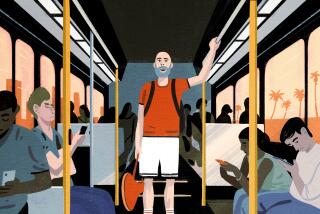Riding the Green Tortoise Bus--’Think Sardines’
- Share via
ON BOARD THE GREEN TORTOISE BUS — An Eric Clapton guitar riff hangs in air redolent of tofu burgers and patchouli oil. It’s time for life-experience show-and-tell.
Leslie Batchelder describes what it was like to be in Berlin when the Wall came down. Trevor Deighton listens intently. He’s from either D.C. or San Francisco--on one coast he’s a bike messenger, on the other a rock climber.
Sprawled on a pile of sleeping bags, Jessica Stone and her boyfriend, Eddie Allen, lay with arms entwined, taking suggestions on naming the child they just found out they’re going to have.
They’re all passengers on the Green Tortoise bus--a traveling commune, a road show on wheels, a new head space with plenty of leg space.
Greyhound was never like this.
Twice a week, the trademark green buses make a 48-hour trip from Seattle to Los Angeles for $79 one way. Compared to $125 on Greyhound and $157 on Amtrak, it’s the cheapest way down the coast.
But a trip on the Tortoise isn’t just about getting from here to there. It’s about what happens in between.
It includes eight hours of sightseeing in San Francisco and a three-hour layover at the company compound in southern Oregon, complete with a vegetarian feast, sauna and--if you’re lucky--an impromptu African drumming session.
“It’s a 24-hour timeout, a place where you don’t have to worry about playing the game,” says driver Steve Spahr, 38.
At 7 a.m. on a clear Seattle morning, 30 passengers mill around in the cold waiting to board the bus. Fresh-faced young women clutch sleeping bags and pillows; to look at them, they might be on their way to a slumber party.
Spahr, a bear of a man with a mischievous grin and a wild black beard, is the chaperon of this party. For him, driving the Tortoise isn’t a job, it’s a calling. He sets the karma for the trip.
Like a high priest of busdom, Spahr presides over “the nightly miracle” as the Tortoise’s handcrafted interior transforms to a vast expanse of cushions--enough to sleep 45 comfortably. Seats fold out and tables fold up.
Spahr initiates new passengers into the intricacies of “the leg thing.”
“Think sardines, people,” he says, interlocking his fingers in illustration. Bundled in their sleeping bags, passengers lay perpendicular to the side of the bus, intertwined like the teeth of two combs.
It’s all perfectly respectable. Jolee Darrow, 39, of Vashon Island, Wash., and her three teen-agers traveled to San Francisco to visit her sister. She chose the Tortoise over Amtrak as a chance to teach her 15-year-old football-player son, Caleb, a little tolerance.
“He’s the one with the crew-cut over there,” she says. She points to the front of the bus, where Caleb is in the middle of an energetic game of hearts with a young man sporting a ring in his nose.
“He needs to see that people can be different from him and still be OK. It’s a good experience for him.”
This mobile counterculture was born of a ‘60s wanderlust. Kent Gardner, now 46, was working at his father’s upholstery business in Weymouth, Mass., in 1972 when he bought an old school bus and decided to drive to Central America with his wife and two children.
“It wasn’t that uncommon a thing to do in those days,” says Lyle, Gardner’s 25-year-old son and manager of the bus company.
“For a while when we got back, Dad sold stuff from Guatemala on the streets of Berkeley. He didn’t have the money to take us back to Boston for Christmas. But we had this bus.”
Gardner printed up flyers and sold $75 tickets for a “Home for the Holidays” cross-country trip. He filled the bus with passengers, drove to Boston, made a profit, and a company was born.
“There were lots of so-called underground bus companies in those days,” Lyle says. “The Grey Rabbit, the Pink Flamingo. But we’re the only one’s still running.”
The Tortoise now has a fleet of 10 buses, a staff of 50 and its own bus-renovation garage in Lowell, Ore.; it took in about $1.4 million last year, Gardner says. The company carries 13,000 passengers a year on its West Coast run and on adventure travels to Mexico, Guatemala, Alaska, Belize, the Grand Canyon and New Orleans for Mardi Gras.
At 7 p.m., 12 hours after its departure, the San Francisco-bound bus arrives at the Cow Creek Compound, the Tortoise’s layover site in southern Oregon. Generator-run lights cut a path through dark firs to the appropriately named “Thought Provoking Structure.”
Long, thin saplings are woven to form a huge oval room. Sandwiched between them, a layer of clear plastic keeps out the rain but lets the stars shine through. Hundreds of Christmas-tree lights strung along the ceiling fill the room with a magical glow.
Passengers gather around a large potbellied stove to warm their fingers and sit on benches drinking tea and hot cocoa. While some prepare a vegetarian communal dinner, others check out the sauna.
Down near Cow Creek, shrieks fill the air as 15 or more unclothed travelers burst out of a redwood sauna and plunge into the frigid stream. A snowball fight ensues before they race back to the steam bath.
At the Structure, a young French-Canadian woman just back from a year’s stay in Mali brings out a drum and begins to play. Others join her on drums, guitars and spoons. Nineteen-year-old Anja Becker from Germany stops at the entrance, her glasses fogged from the temperature extremes.
“It’s like a dream,” she whispers as 40 near-strangers make music and dance to an undulating rhythm under the flickering lights.
The next morning, 46 passengers wake in a tangle of sleeping bags as the bus crosses the Bay Bridge into San Francisco. Spahr downshifts, easing the bus to a stop behind the Transbay Terminal downtown.
Passengers spill out onto the sidewalk in the bright California sun and there’s a flurry of activity as address books come out for the ritual exchange. About 20 end their trip here; the rest do some sightseeing, and return for the last leg of the trip, to Los Angeles.
“Everybody got their bags?” Spahr says. Passengers hug Spahr goodby and one presses a leftover orange in his hand. Then they slowly disperse into the workaday crowd, tie-dyed shirts blending in among business suits.
More to Read
Sign up for The Wild
We’ll help you find the best places to hike, bike and run, as well as the perfect silent spots for meditation and yoga.
You may occasionally receive promotional content from the Los Angeles Times.






